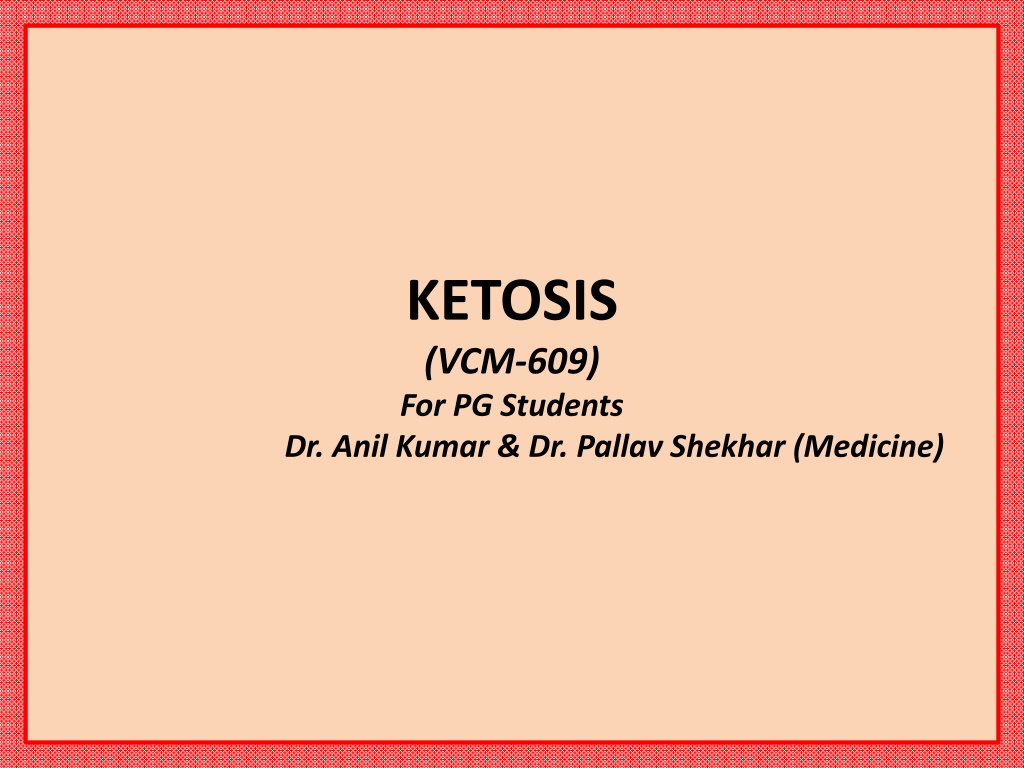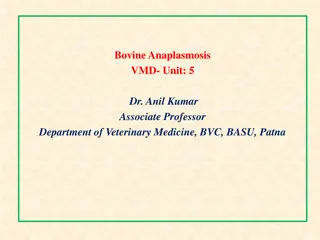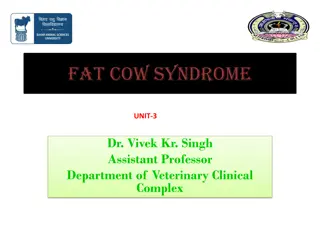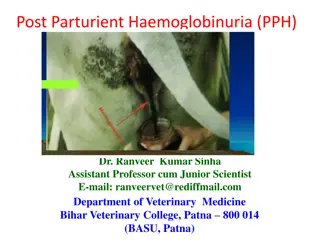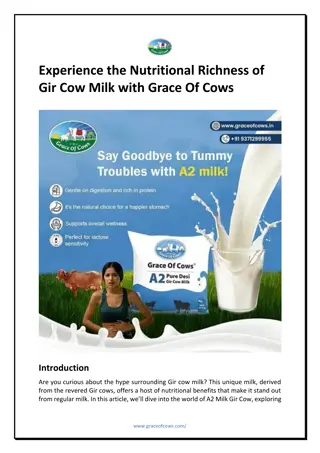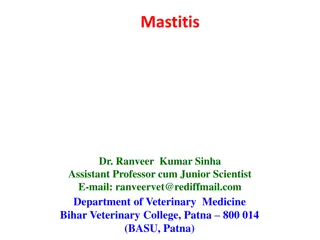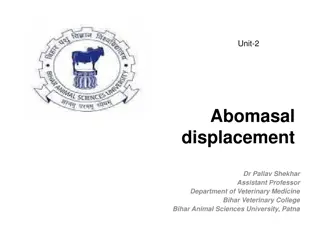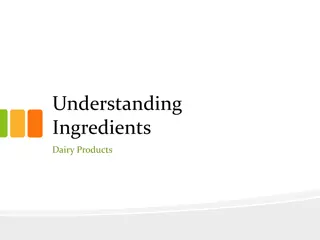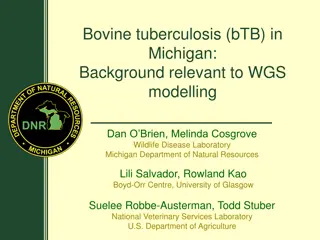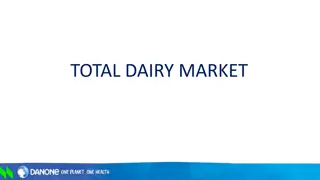Understanding Bovine Ketosis in Dairy Cows
Bovine ketosis is a metabolic disease affecting lactating dairy cows, characterized by weight loss, reduced milk production, and neurological abnormalities. It is primarily caused by a negative energy balance post-parturition, leading to the mobilization of body fat and protein stores for energy production. Clinical signs include lethargy, weight loss, and abnormal behaviors, with potential serious consequences if left untreated.
Download Presentation

Please find below an Image/Link to download the presentation.
The content on the website is provided AS IS for your information and personal use only. It may not be sold, licensed, or shared on other websites without obtaining consent from the author. Download presentation by click this link. If you encounter any issues during the download, it is possible that the publisher has removed the file from their server.
E N D
Presentation Transcript
KETOSIS (VCM-609) For PG Students Dr. Anil Kumar & Dr. Pallav Shekhar (Medicine)
BOVINE KETOSIS (Acetonemia, Ketonemia) Ketosis is a metabolic disease of lactating dairy cows characterized by weight loss, pica, inappetance, decreased milk production, and neurologic abnormalities that usually occur during the first 6 wk of lactation. Ketosis occurs worldwide whenever dairy cows are selected and fed for high milk production. It affects both primiparous and multiparous cows. Incidence is highest during the third and fourth weeks of lactation in closely confined stabled dairy cows that are improperly fed and conditioned during the dry period and early lactation. Ketosis can occur whenever a cow goes off feed for any reason. Significant predisposing and concomitant conditions are retained fetal membranes, metritis, mastitis, displaced abomasum, fatty livers, environmental nutrition, and mismanagement. stresses, faulty
Etiology and Pathogenesis Ketosis is basically the result of a negative energy balance in the 6 wk after parturition. The cow is unable to eat or assimilate enough nutrients to meet her energy needs for maintenance and milk production during this period. Therefore, blood glucose levels drop and hypoglycemia results. In an effort to correct this condition, body fat and limited protein stores are mobilized in the form of triglycerides and amino acids for gluconeogenesis. Ketone bodies (acetoacetic acid, acetone, and -hydroxybutyric) are produced during the mobilization process. This occurs to a limited degree in practically all high-producing cows in early lactation, and only a subclinical ketosis develops if the herd is properly fed and conditioned and free of predisposing factors. However, if this is not the case, clinical ketosis develops when the production and absorption of ketone bodies exceeds their use as an energy source. This results in increased blood ketones, free or nonesterified fatty acids, and decreased blood glucose. Ketone bodies are produced primarily in the liver but also in smaller quantities in the mammary gland and rumen wall
Clinical Findings Onset of signs is usually gradual, and close observation is required to determine their presence. Initial signs include a slight decrease in feed intake, drop in milk production, lethargy, and firm mucus-covered stools. As the disease progresses, a marked weight loss occurs that may approach several hundred pounds in a few days. Pica is often seen in which affected cows refuse grain and seek coarse materials such as coarse hay, straw, ground, and even tree twigs (selective feeding). As the disease progresses, depression deepen, movement is limited, and cows stand with a humpbacked posture. There may be an acetone odour to the breath, urine, or milk. Although most cows exhibit the lethargic wasting signs, some show frenzy and aggression. They may compulsively lick metal stanchions, mangers, or their own bodies. Head or nose pressing may occur along with chewing and bellowing.
Walking may be abnormal with staggering, circling, and falling. Some cows seriously injure themselves during these activities, and death may result. If ketosis is untreated, milk production decreases to an insignificant amount that does not require much energy to produce. Because energy requirements for body maintenance are relatively small compared with those for high milk production, intake of carbohydrate precursors (as described in the Krebs cycle) may gradually reach demand, and a slow recovery occurs. However, for the cow to make a complete recovery and to reach her full potential predisposing conditions must also be successfully treated. for milk production, the
Diagnosis It is extremely important to obtain a complete history when ketosis is suspected. Special attention should be given to length of dry period, nutrition during the dry period, parturition date, nutrition since parturition, and daily milk production records, if available. Rapid loss of body weight, depression, decreased appetite, pica, drop in milk production, bizarre behavior, and a near normal temperature should alert the diagnostician to suspect ketosis. Oftentimes, an observant caretaker may have detected an abnormal odor from the cow's breath, urine, or milk. All cows suspected of having ketosis should receive a thorough physical examination along with Rothera's test for ketone bodies. Rothera's test for ketones is usually conducted on urine, but a positive urine test is usually not considered to be diagnostic of clinical ketosis because ketones are so highly concentrated in urine (up to 1200 mg/dL).
Because ketone levels in milk are much lower (usually not exceeding 50 mg/dL in clinical cases) and less variable, a positive Rothera's test of milk is considered to be a much more accurate diagnosis of clinical ketosis. Blood glucose levels are also helpful in arriving at a diagnosis. Normal levels of 40-60 mg/dL drop to below 25 mg/dL in clinical ketosis. Differential diagnoses should include but not be limited to hypocalcemia, retained fetal indigestion, abomasal displacement, traumatic reticulitis, poisoning, pyelonephritis, listeriosis, and rabies. Treatment The treatment should be initiated through: Replacement therapy Hormonal therapy Miscellaneous therapy membranes, metritis,
Replacement therapy: Routine treatment is IV administration of 500 mL of 50% glucose and IM administration of the glucocorticoid of choice,and and provide improvement in clinical signs and milk production. This will lead to: Transient hyperglycemia Increase insulin secretion Decrease Glucagon Decreased NEFA Propylene glycol (225 g, b.i.d. for 2 days, followed by 100 g, daily for 2 days) or other glucose precursors are also administered PO in many cases Milk production may temporarily decrease after glucocorticoid administration but increases rapidly after several days. The response to propylene glycol is slow and is often used as supportive treatment after administration of glucocorticoids and glucose.
Hormonal therapy: Glucocorticosteroids (Dexamethasone, 40mg) Insulin as protamine zinc @200-300 IU/Animal, SC every 24-48 hrs. It is given in conjunction with either glucose or corticosteroids. Anabolic steroids (trenbolone acetate), lactational ketosis and ketosis in late pregnant cows that are overfat, stressed, or have twin fetuses, but banned in food animals. Miscellaneous treatments: B12 and cobalt Cysteamine (a biological precursor of coenzyme A) and also sodium fumarate have been used to treat cases of the disease, but not generally adopted. The recommended dose rate of cysteamine is 750 mg IV for three doses at 1-3 day intervals.
PREVENTION Propylene glycol has been drenched to cattle in early lactation at doses varying from 350 to 1000 mL daily for 10 days after calving control /prevent clinical and subclinical ketosis A dose of 1 L per day given as an oral drench for 9 days prior to parturition has also been shown efficacious. Glycerol in large volume of water(to reduce staggering, depression and diuresis )can be substituted for propylene glycol at equivalent dose rates. Ionophores (Monensin as slow releasing capsule contain 25g, 2-4 weeks before calving), alter bacterial flora of the rumen, leading to decreases in Gram positive bacteria, protozoa, and fungi and increases in Gram-negative bacteria. The net effect of these changes in bacterial flora is increased propionate production and a decrease in acetate and butyrate production. Various feed additives such as propylene glycol, sodium propionate, yeasts, niacin, recommended. choline, etc. have been
To effect a rapid and lasting recovery, any predisposing conditions must also be eliminated, and proper nursing and nutrition provided Cows should be properly conditioned during late lactation and the dry period. They should be fed so that body score at calving will be 3.5 on a 5- point scale. About 2 wk before parturition, cows should be started on a small amount of the concentrate ration they will receive during early lactation. The amount of concentrate should be gradually increased so that at parturition, the cow will be consuming 1 lb per 150 lb body wt daily. Because feed intake is normally limited voluntarily just before and immediately after parturition, it is extremely important not to overfeed during this period, which may throw the cow off feed completely. The ration should contain adequate amounts of essential vitamins and minerals.
